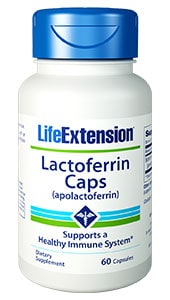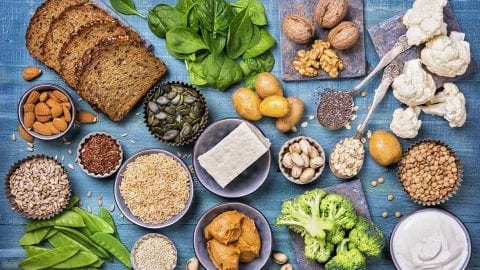By Monica Mollica & Will Brink
As seen in The Life Extension Magazine May 2014 ©
Lactoferrin has been experiencing an increased interest by researchers and medical professionals, and rightly so: It’s shown an astounding array of potential benefits to human health and disease prevention. The wide range of potential health and disease fighting properties of lactoferrin are covered extensively in two prior articles “The Bioactive Peptide that Fights Disease” and a later update outlining recent research findings with additional research found . This article shows a recently discovered benefit of this unique peptide that were quite unexpected.
What Is Lactoferrin?
In a nut shell, Lactoferrin is a multi-functional peptide, derived from whey protein; in bovine milk it’s present at approximately 0.5-1.5% of total whey proteins 1, and 0.1 g/liter 2. In addition to its known anti-bacterial 3, anti-viral 4), immune strengthening 5, antioxidant 6, 7, anti-inflammatory 7 and cancer-preventive potential 8, recent studies have discovered novel targets of lactoferrin that can help with fat loss and improve insulin sensitivity and glucose control, which are also essential components to weight loss and overall health.
Lactoferrin for fat loss
A role for lactoferrin in reducing adiposity was first discovered in fat cell culture studies. It was found that lactoferrin specifically inhibits fat accumulation in fat cells, as well as formation of new fat cells (a process called adipogenesis) 9, 10.
The potential anti-obesity effect of lactoferrin has been shown in obese mice, where a lactoferrin rich diet resulted in increased fat loss 11. Another study on mice found that a lactoferrin rich whey protein isolate prevents obesity by dose- dependently preventing fat gain and fatty liver formation during spontaneous feeding, and enhancing fat los during a calorie restricted diet 12.
Research is showing that lactoferrin might help with fat loss in humans as well. Higher blood levels of lactoferrin are associated with lower BMI (an obesity indicator), waist-to-hip ratio and fasting triglyceride and glucose concentrations 13, 14. A notable study supplemented healthy men and women, aged 22–60 years, with 300 mg lactoferrin (enteric coated) tablets per day for 8 weeks 15. Subjects were told to maintain their regular food habits. It was found that the lactoferrin supplement, compared to placebo, resulted in a 12.4% significant reduction in intra-abdominal (visceral) fat 15. The lacroferrin group also showed significant decreases in body weight (-3.3 lb), BMI (-0.6) and hip circumference (-1 inch), while the placebo group instead gained 0.45 lb body weight. In addition, there was a 1.7 inch reduction in waist circumference in the lacroferrin group. It was concluded that lacroferrin appears to be a promising supplement for counteracting intra-abdominal fat accumulation.
Lactoferrin for improved insulin sensitivity and blood sugar control
There are also indications for a role for lactoferrin in the regulation of glucose control. In humans, higher blood levels of lactoferrin are associated with lower blood sugar levels and higher insulin sensitivity 14, and supplementing mice on high-fat diet with a lactoferrin rich whey protein isolate was found to improve glucose tolerance compared to the same diet supplemented with casein 12.
Metabolic endotoxemia – another fat fighting target of lactoferrin
Another way lactoferrin can help in the fight against obesity and its associated metabolic and cardiovascular complications is by binding to and inactivating an endotoxin called lipopolysaccharide 16. The gut houses a vast microbial community of diverse bacterial species 17, 18. Lipopolysaccharide is continuously produced by Gram-negative Intestinal bacteria, and absorbed in small quantities into the blood stream 19, 20. Unhealthy food habits, like the typical Western diet high in fat and processed foods, and low in fiber), can increase production, absorption and blood levels of lipopolysaccharide, and cause a condition called “metabolic endotoxemia” 19-21.
Metabolic endotoxemia is a condition characterized by two- to threefold increases in blood lipopolysaccharide levels 19, 20, and there are indications that it might initiate insulin resistance and obesity 19, 22. In addition, it elicits a chronic low-grade pro-inflammatory and pro-oxidative stress status that can damage organs in the body 23-25. Metabolic endotoxemia can thus represent a molecular link between obesity and its related diseases. This is supported by the recent finding that people with overweight, obesity, and metabolic syndrome (particularly, low HDL cholesterol levels) have higher lipopolysaccharide-binding protein levels 26. Lipopolysaccharide-binding protein might be a biomarker to indicate activation of the immune system in response to microbial compounds, particularly lipopolysaccharide 27-30. These findings are consistent with microbial exposure playing a role in these inflammatory, metabolic abnormalities 26.
Further evidence for the involvement metabolic endotoxemia in obesity development is the finding that it directly stimulates formation of new fat cells 31. Thus, lactoferrin might inhibit new fat cell formation via several different mechanisms 9, 10.
Conclusion
Lactoferrin continues to demonstrate a wide range of potential benefits to humans and now appears to be an effective weight loss agent. The precise dose of lactoferrin that’s optimal for fat loss in humans has yet to be fully studied, but 300-1000mg+ is good target dose until further studies are carried out, and the only side effect is likely to be improved health…
NOTE: It should be noted also that lactoferrin can come in two forms; called apo-lactoferrin (apo-LF) and halo-lactoferrin (halo-LF). One role of lactoferrin is to sequester and bind iron until it’s needed by the immune system to fight pathogens. Apo- lactoferrin is iron depleted. Halo-lactoferrin contains iron. Although studied suggest both forms are beneficial, Apo-LF appears to be the more potent of the two as it relates to a number of benefits seen with lactoferrin. The vast majority of companies that sell lactoferrin sell the Halo (iron saturated) from. The company I’d recommend for apo-LF form is the Life Extension Foundation but there may be others I’m not aware of.
References:
1. Artym J, Zimecki M. Milk-derived proteins and peptides in clinical trials. Postepy Hig Med Dosw (Online). 2013;67:800-816.
2. Korhonen HJ. Bioactive milk proteins and peptides: from science to functional applications. Aust J Dairy Technol. 2009;64:16-21.
3. Tomita M, Bellamy W, Takase M, Yamauchi K, Wakabayashi H, Kawase K. Potent antibacterial peptides generated by pepsin digestion of bovine lactoferrin. J Dairy Sci. Dec 1991;74(12):4137-4142.
4. Harmsen MC, Swart PJ, de Bethune MP, et al. Antiviral effects of plasma and milk proteins: lactoferrin shows potent activity against both human immunodeficiency virus and human cytomegalovirus replication in vitro. J Infect Dis. Aug 1995;172(2):380-388.
5. Zimecki M, Wlaszczyk A, Cheneau P, et al. Immunoregulatory effects of a nutritional preparation containing bovine lactoferrin taken orally by healthy individuals. Arch Immunol Ther Exp (Warsz). 1998;46(4):231-240.
6. Shoji H, Oguchi S, Shinohara K, Shimizu T, Yamashiro Y. Effects of iron-unsaturated human lactoferrin on hydrogen peroxide-induced oxidative damage in intestinal epithelial cells. Pediatr Res. Jan 2007;61(1):89-92.
7. Fernandez-Real JM, Garcia-Fuentes E, Moreno-Navarrete JM, et al. Fat overload induces changes in circulating lactoferrin that are associated with postprandial lipemia and oxidative stress in severely obese subjects. Obesity (Silver Spring). Mar 2010;18(3):482-488.
8. Sekine K, Ushida Y, Kuhara T, et al. Inhibition of initiation and early stage development of aberrant crypt foci and enhanced natural killer activity in male rats administered bovine lactoferrin concomitantly with azoxymethane. Cancer Lett. Dec 23 1997;121(2):211-216.
9. Moreno-Navarrete JM, Ortega FJ, Ricart W, Fernandez-Real JM. Lactoferrin increases (172Thr)AMPK phosphorylation and insulin-induced (p473Ser)AKT while impairing adipocyte differentiation. Int J Obes (Lond). Sep 2009;33(9):991-1000.
10. Yagi M, Suzuki N, Takayama T, et al. Lactoferrin suppress the adipogenic differentiation of MC3T3-G2/PA6 cells. J Oral Sci. Dec 2008;50(4):419-425.
11. Pilvi TK, Harala S, Korpela R, Mervaala EM. Effects of high-calcium diets with different whey proteins on weight loss and weight regain in high-fat-fed C57BL/6J mice. Br J Nutr. Aug 2009;102(3):337-341.
12. Shia J, Tauriainena E, Martonen E. Whey protein isolate protects against diet-induced obesity and fatty liver formation. Int Dairy J. 2011;21:513–522.
13. Moreno-Navarrete JM, Ortega FJ, Bassols J, Castro A, Ricart W, Fernandez-Real JM. Association of circulating lactoferrin concentration and 2 nonsynonymous LTF gene polymorphisms with dyslipidemia in men depends on glucose-tolerance status. Clin Chem. Feb 2008;54(2):301-309.
14. Moreno-Navarrete JM, Ortega FJ, Bassols J, Ricart W, Fernandez-Real JM. Decreased circulating lactoferrin in insulin resistance and altered glucose tolerance as a possible marker of neutrophil dysfunction in type 2 diabetes. J Clin Endocrinol Metab. Oct 2009;94(10):4036-4044.
15. Ono T, Murakoshi M, Suzuki N, et al. Potent anti-obesity effect of enteric-coated lactoferrin: decrease in visceral fat accumulation in Japanese men and women with abdominal obesity after 8-week administration of enteric-coated lactoferrin tablets. Br J Nutr. Dec 2010;104(11):1688-1695.
16. Wakabayashi H, Takase M, Tomita M. Lactoferricin derived from milk protein lactoferrin. Curr Pharm Des. 2003;9(16):1277-1287.
17. Sanz Y, Santacruz A, Gauffin P. Gut microbiota in obesity and metabolic disorders. Proc Nutr Soc. Aug 2010;69(3):434-441.
18. Jeffery IB, O’Toole PW. Diet-microbiota interactions and their implications for healthy living. Nutrients. Jan 2013;5(1):234-252.
19. Cani PD, Amar J, Iglesias MA, et al. Metabolic endotoxemia initiates obesity and insulin resistance. Diabetes. Jul 2007;56(7):1761-1772.
20. Neves AL, Coelho J, Couto L, Leite-Moreira A, Roncon-Albuquerque R, Jr. Metabolic endotoxemia: a molecular link between obesity and cardiovascular risk. J Mol Endocrinol. 2013;51(2):R51-64.
21. Mani V, Hollis JH, Gabler NK. Dietary oil composition differentially modulates intestinal endotoxin transport and postprandial endotoxemia. Nutr Metab (Lond). 2013;10(1):6.
22. Manco M, Putignani L, Bottazzo GF. Gut microbiota, lipopolysaccharides, and innate immunity in the pathogenesis of obesity and cardiovascular risk. Endocr Rev. Dec 2010;31(6):817-844.
23. Suganami T, Tanimoto-Koyama K, Nishida J, et al. Role of the Toll-like receptor 4/NF-kappaB pathway in saturated fatty acid-induced inflammatory changes in the interaction between adipocytes and macrophages. Arterioscler Thromb Vasc Biol. Jan 2007;27(1):84-91.
24. Puppa MJ, White JP, Sato S, Cairns M, Baynes JW, Carson JA. Gut barrier dysfunction in the Apc(Min/+) mouse model of colon cancer cachexia. Biochim Biophys Acta. Dec 2011;1812(12):1601-1606.
25. Stoll LL, Denning GM, Weintraub NL. Potential role of endotoxin as a proinflammatory mediator of atherosclerosis. Arterioscler Thromb Vasc Biol. Dec 2004;24(12):2227-2236.
26. Gonzalez-Quintela A, Alonso M, Campos J, Vizcaino L, Loidi L, Gude F. Determinants of serum concentrations of lipopolysaccharide-binding protein (LBP) in the adult population: the role of obesity. PLoS One. 2013;8(1):e54600.
27. Schumann RR. Old and new findings on lipopolysaccharide-binding protein: a soluble pattern-recognition molecule. Biochem Soc Trans. Aug 2011;39(4):989-993.
28. Hudgins LC, Parker TS, Levine DM, et al. A single intravenous dose of endotoxin rapidly alters serum lipoproteins and lipid transfer proteins in normal volunteers. J Lipid Res. Aug 2003;44(8):1489-1498.
29. Opal SM, Scannon PJ, Vincent JL, et al. Relationship between plasma levels of lipopolysaccharide (LPS) and LPS-binding protein in patients with severe sepsis and septic shock. J Infect Dis. Nov 1999;180(5):1584-1589.
30. Schumann RR, Latz E. Lipopolysaccharide-binding protein. Chem Immunol. 2000;74:42-60.
31. Luche E, Cousin B, Garidou L, et al. Metabolic endotoxemia directly increases the proliferation of adipocyte precursors at the onset of metabolic diseases through a CD14-dependent mechanism. Mol Metab. 2013;2(3):281-291.
Will Brink is the owner of the Brinkzone Blog. Will has over 30 years experience as a respected author, columnist and consultant, to the supplement, fitness, bodybuilding, and weight loss industry and has been extensively published. Will graduated from Harvard University with a concentration in the natural sciences, and is a consultant to major supplement, dairy, and pharmaceutical companies.
His often ground breaking articles can be found in publications such as Lets Live, Muscle Media 2000, MuscleMag International, The Life Extension Magazine, Muscle n Fitness, Inside Karate, Exercise For Men Only, Body International, Power, Oxygen, Penthouse, Women’s World and The Townsend Letter For Doctors.
He’s also been published in peer reviewed journals.
Will is the author of the popular e-books, both accompanied by private members forum access , Bodybuilding Revealed & Fat Loss Revealed.
You can also buy Will’s other books on Amazon, Apple iBook, and Barnes and Noble.







What about colostrum, Will? Is is better to take whole colostrum or lactoferrin only? Or maybe supplement with both?
The content and quality of lactoferrin can vary greatly in colostrum, as well as the quality of colostrum can vary widely. I’d use a standardized product for lactoferrin. You can add colostrum if you wish for its possible health benefits and such, but there’s no reason to per se.
You mentioned that one study used enteric coated tablets of lactoferrin. Does that signal that lactoferrin needs to be protected from stomach acid in order to be most effective?
There may be some benefits to enteric coating, the vast majority of studies didn’t use that technology, we know it’s not required for the benefits of lactoferrin per se. I’m still looking into that one, but it’s clearly not essential.
Hi, Will.Lactoferrincin, degraded form of lactoferrin shows good antibiotic activity, however, enteric-coated lactoferrin does good anti-obesitic effect, according to related papers, published by T. Ono et al.
Jarrow also produces apo-lactoferrin although I have no idea of their quality control. Both the Jarrow product and the Life Extensions product are available through Amazon at a somewhat better price.
I was not aware of Jarrow having apo-L. Jarrow is generally a good company. I do know LEF was the first to sell it as I was the one who advised them to do so! 🙂
As always, great info. Will, what’s your opinion on taking this in addition to the FLR E/C stack?
As it’s not a stimulant, no reason you can’t. Unknown what, if any, added effects on fat loss it may have combined with EC. Lactoferrin has so many potential health benefits regardless, hard to go wrong there, but can’t promise additional fat loss with EC per se.
Is there a problem with taking lactoferrin if you have a milk allergy? If you have high ferritin levels?
Pure lactoferrin should have no effects on milk allergies, but I’d test a small amount first and assess your response. The iron depleted version of lactoferrin (see link at end of the article) call Apo-LF should help control iron levels (lactoferrin being an iron sequestering peptide) but I don’t believe that’s been formally looked at in studies of people with elevated iron levels. At the very least, the Apo form shouldn’t add anything to your iron load.
Hi Will,
Great info as always! Will you be adding Lactoferrin to the supplement reviews on FLR?
Best,
Jose
When I update Fat Loss Revealed, no doubt I’ll have to add lactoferrin as a “worth a try” supplement.
I would like to know whether the amount of lactoferrin I would get if I would take a “usual” amount of whey protein isolate or whey protein concentrate for a meal (I use at breakfast). I realize the answer would be inexact. A range would then be helpful. And perhaps a recommendation or two for high lactoferrin wheys.
Would you get any of these same benefits mentioned(fat loss etc.) by drinking small whey shakes throughout the day?
I’ve found the opposite of what you state, that most companies sell Halo Lactoferrin instead of Apolactoferrin. Do you know where I can get Halolactoferrin?
You may want to re read what I wrote. Per what’s in bold above: “The vast majority of companies that sell lactoferrin sell the Halo (iron saturated) from.” Studies suggest the Apo form superior and I give the name of the company I recommend and use for the Apo form above
Good luck.
Sorry, I read my comment back to myself and it was confusing! I did read what you say in bold but I’m looking for Halo Lactoferrin because I can’t seem to find it anywhere! This isn’t for weight loss, it’s for chronic anemia and have read that Apolactoferrin may make it worse. I’m just having a hard time finding the iron saturated form. Thanks again!
Can this be used forever and not lose it’s potency in the human body, i.e. needing more
I know of no reason it can’t be used life long.
Hi Will there is a product out there called GCX10 BY Eric Serrano MD and Scott H. Mendelson which uses enteric coated lactoferrin based on a japnese study. I am sure you would be aware of the study I am referring to. Basically they claim it cuts out stubborn visceral fat like crazy and is mainly for that. But there are no products on market which are enteric coated and this study and Eric Serrano MD and Scott H. Mendelson claims for it to work it has to be enteric coated and not just normal lectoferrin. Their product is very expensive. What would you advice to try this out for the enteric coated stuff or would you say it would give the same effect enteric coated or not like the one you recommand life extension brand. My subcutaneous fat is on low end so if i breath out and hit a abs shot my abs are visible but the second i leave it relaxed i look 4 months pregnant !! When I go really low fat visceral fat goes down quite a bit and gut disappears but as soon as I go on a little bulk or eat over maintainance it seems it goes straight to visceral fat accumulation. Kindly let me know what do you think best way to target visceral fat if its not lactoferrin as claimed in the Japanese study . Many Thanks
As you’ll see above, some discussion on enteric coating.
I was very intrigued by this article from you Will. You talked about using Whey protein isolate as far as it being more beneficial Lacto-Ferrin wise. Is it that because it is cleaner and almost 100% carb free, rather than Whey Concentrate which I use. You mentioned isolate as well having higher glucose tolerance than Casein.
So, it has me thinking about making a switch to isolate primarily. Although I don’t have issues with sugar levels or obesity because I work out like crazy and eat a clean diet.
I’d like to see more studies on Lacto-Ferrin and different protein powder sources.
Thanks Will.
Hi, Will – just started using this, from LE, per recommendation (and price was right on Amazon). Quick question: do you think there is any issue of uptake/absorbency if stacked with my morning multivitamin? It doesn’t seem like the simple peptide would compete, but appreciate your view.
Thanks as always!
I’m not aware on any issues of absorption with vitamins. Should be fine.
Thanks so much for the fast reply, Will – will get back to the forum in a month or so with some results.
Will,
I am inferring that the additional lactoferrin (300mg) mentioned above would be beneficial;y additive, EVEN IF one was already taking a daily whey isolate protein shake, given the small percentage of lactoferrin in whey isolate alone.
Is that a correct inference?
Thanks
Jim
Yes, the additional dose could help as studies often used multi gram amounts.
Great article on Lactoferrin as a supplement to help reduce inflammation and strengthen your immune system, Monicca and Will!
I always have a question Will. Why is isolate better than Casein better to improve glucose tolerance or anti-inflammatory properties. I personally use whey concentrate and have been for years.
You educate us and make me take action in being healthier and eating properly, along with using high quality supplements.
Much respect guys.
Is there a difference in the amount of Lactoferrin in whey protein concentrate which I use, versus an isolate?
I realize there aren’t huge amounts of L-ferrin in whey and casein,but I think just including a shake a day can help in controlling weight and bodyfat. Am I right Monica and Will?
Depends on how the whey is processed and other factors, but if WPC has the same % as WPI, then you’ll get a higher dose from the WPI on a gram for gram basis by the simple fact WPI has a higher % of protein, which should include LF. For more precise numbers and info/refer to additional articles linked. There’s no LF in casein of any note.
Hi – thank you for the YT video and this article, much appreciated. Is it necessary to find/buy lactoferrin caps that are enteric coated for weight/fat loss effectiveness? Thanks so much. Scooter
Does Lactoferrin have a direct beneficial effect on fatty liver disease or nonalcoholic fatty liver disease?
I have been using lactoferrin from Life Extension for about 2 years now. It has helped keep my ferritin levels down but has not helped with weight loss or glucose levels. What may be causing the difference?
Thanks.
Hi Will
Great article. Short, simple and very well written. Kudos to your work. Little bit information which I know is Lactoferrin directly reduces perilipin levels, in essence helping to open the gate so that stored fat particles can flow out of fat cells. Therefore it helps to reduce body fat. You can also go with stenobolic. Stenabolic directly binds to a protein in the body and makes a user more active. And therefore, users experience a lot of positive effects, including improvement in endurance, the decrease in extra fat, and many other health benefits. It is one of the newest advances in pharmacology but it has been used by numerous athletes and fitness enthusiast across the globe.